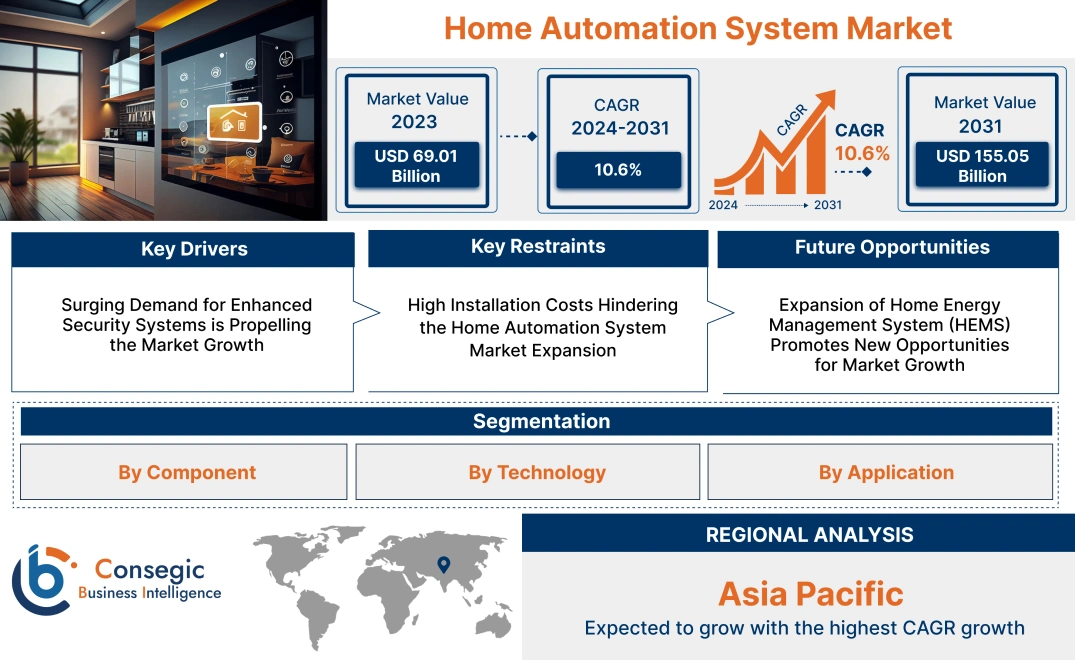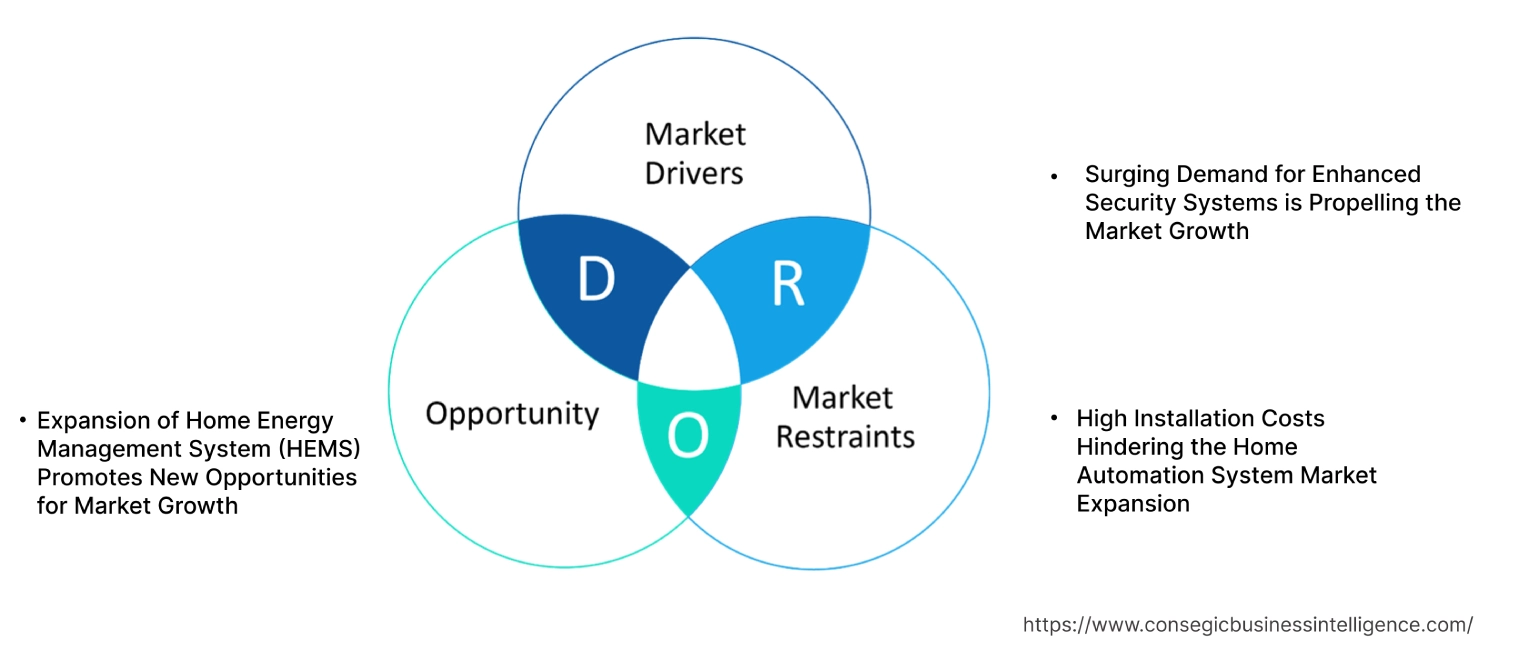- Summary
- Table Of Content
- Methodology
Home Automation System Market Size:
Home Automation System Market size is estimated to reach over USD 155.05 Billion by 2031 from a value of USD 69.01 Billion in 2023 and is projected to grow by USD 75.13 Billion in 2024, growing at a CAGR of 10.6% from 2024 to 2031.
Home Automation System Market Scope & Overview:
A home automation system refers to the integration of technology within residential space to automate and control various household functions and devices. These systems allow users to manage their home's lighting, heating, security, entertainment, and appliances from one central point accessible through a smartphone, tablet, or voice-activated device. Additionally, it enables users to schedule lighting, adjust thermostats remotely, monitor security systems in real time, and access smart home devices. Furthermore, these systems offer a multitude of benefits including enhanced convenience, increased energy efficiency, higher security, and the ability to automate daily tasks and create personalized settings. The aforementioned benefits of these systems are major determinants for increasing their deployment in the residential sector.
Home Automation System Market Insights:
Key Drivers:
Surging Demand for Enhanced Security Systems is Propelling the Market Growth
Smart security systems are often integrated with home automation setup, allowing them to work seamlessly with other devices. As concerns about safety and security rise, consumers are increasingly turning to smart security solutions that offer real-time monitoring, remote access, and advanced features including motion detection and facial recognition. Additionally, technological advancements including Artificial Intelligence (AI) analytics, robotics, and real-time alerts, enhance these systems to provide robust security and prevent threats.
- In September 2021, Amazon introduced Astro, a home robot designed to assist with tasks including home monitoring, setting up routines, and accessing the devices remotely. Astro integrates with Amazon's Alexa and moves around the home space providing live video feeds, detecting unusual activities, and sending alerts, enhancing the security systems in home automation.
Therefore, technological advancements in security systems provide real-time monitoring, which is fueling the home automation system market trend.
Key Restraints :
High Installation Costs Hindering the Home Automation System Market Expansion
Advanced automation system necessitates considerable resources like intelligent sensors, control panels, and other integrated devices. Furthermore, the price of installing and integrating systems professionally can add to overall costs. This huge cost might discourage potential buyers, especially those who are on tight budgets or distrustful about putting their money into new technologies. Additionally, high initial expenditures limit market penetration as most consumers would choose cheaper conventional options instead of elaborate home automation systems. This makes it hard to keep up with demands for such products in regions where price is a major factor.
- For instance, a fully integrated home automation system from Control4, including smart lighting, climate control, and security features ranges from $1,000 to over $10,000, depending on the complexity and extent of automation desired.
Therefore, tackling these financial matters as well as coming up with more affordable options would be fundamental for a wider acceptance and increase in sales of home automation products.
Future Opportunities :
Expansion of Home Energy Management System (HEMS) Promotes New Opportunities for Market Growth
A Home Energy Management System optimizes and controls household energy generation, storage, and usage. By integrating smart devices and energy data from different sources, HEMS provides real-time insights and management tools to enhance energy efficiency. Home automation systems play a crucial role in demand response programs that help balance the energy supply.
- In January 2023, Schneider Electric launched Schneider Home a sustainable home energy management system aimed at offering information on energy usage. The package consists of a home battery for storing clean energy, a powerful solar inverter, an intelligent electrical panel, an electric vehicle charger, and smart electric sockets and light switches - all managed through the user-friendly Schneider Home App. Homeowners can access unique intelligence with the ability to track energy usage for each appliance, determine power priorities during an outage, and prevent costly electrical upgrades when buying an EV.
Thus, the expansion of home energy systems is expected to propel the home automation system market opportunities.
Home Automation System Market Segmental Analysis :
By Component:
Based on component the market is segmented into hardware, software, and service.
Trends in the Component:
- There is a rise in managed services and subscription-based models for home automation, where users pay for ongoing support, maintenance, and upgrades. This model offers convenience and ensures that systems remain up-to-date with the latest features and security for the industry.
- As data privacy concerns grow software solutions are placing a stronger emphasis on security features including end-to-end encryption and data storage.
The hardware component accounted for the largest revenue share of 49.33% in the year 2023.
- Home automation system hardware includes smart devices including thermostats, lighting systems, security cameras, and smart locks.
- These devices are crucial for building a connected home and are often the first step for consumers venturing into home automation.
- Additionally, technological advancements in these devices provide energy efficiency, high performance, and integration capabilities.
- In January 2023, Samsung launched SmartThings Station, a smart home hub designed to centralize control of various smart devices. These devices integrate with Samsung's SmartThings ecosystem and support a wide range of protocols facilitating seamless connectivity and control.
- Therefore, according to the analysis, hardware devices integrated into the system are boosting the home automation system market demand.
The software component segment is anticipated to register the fastest CAGR during the forecast period.
- Home automation systems are increasingly leveraging AI IoT and machine learning to offer more personalized and intelligent experiences.
- These technologies enable systems to learn user preferences, predict needs, and automate tasks more effectively, enhancing overall functionality.
- In October 2022, Google introduced upgrades for the Google Home app, which serves as a central control hub for Google's smart home ecosystem. The app's new features include improved device management, enhanced automation capabilities, and better integration with third-party services.
- Thus, as per the home automation system market analysis, the software component is expected to proliferate the global home automation system market share.
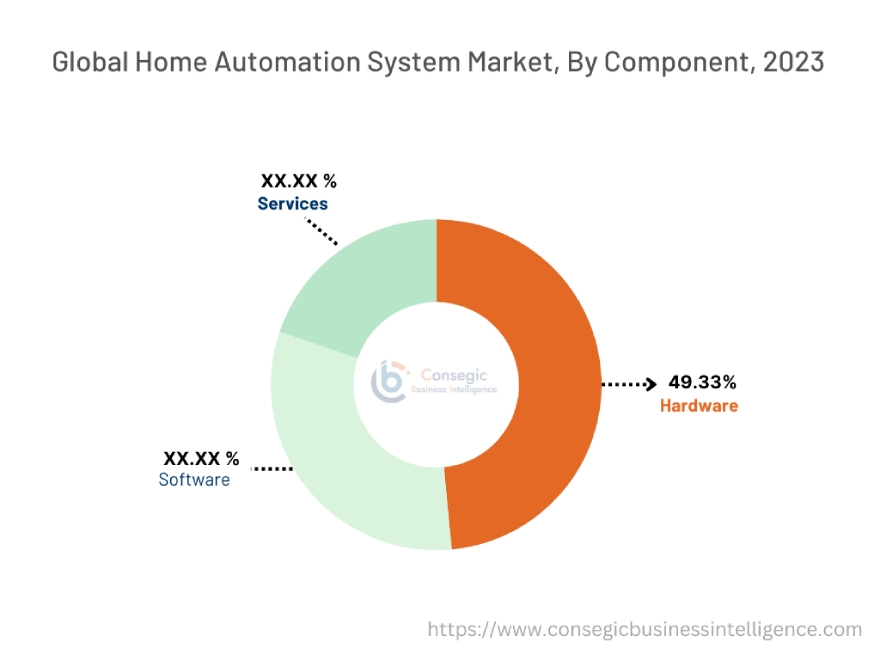
By Technology:
Based on technology the market is segmented into Wired, Wireless, and others.
Trends in the technology:
- Wired technologies are increasingly being integrated with broader building management systems. This integration allows for centralized control of lighting, HVAC, and other systems, enhancing overall efficiency and management.
- Hybrid technologies that combine wired and wireless components are becoming more prevalent. These systems leverage the benefits of both technologies, offering the reliability of wired connections with the flexibility of wireless connections.
The wireless technology segment accounted for the largest revenue share in the year 2023 and is anticipated to register the fastest CAGR during the forecast period.
- Wireless technology offers significant advantages in terms of ease of installation and flexibility.
- This technology is well suited for integration with major intelligent virtual assistants including Amazon Alexa, Google Assistant, and Apple Homekit.
- Additionally, this integration allows for seamless control of a wide range of smart devices from a unified platform.
- In June 2021, Amazon launched Echo Show 10, a smart display featuring a rotating screen, improved audio, and seamless integration with Amazon Alexa, showcasing the capabilities of wireless connectivity in enhancing smart home functionality and user experience.
- Consequently, as per the analysis, the seamless connectivity of wireless technology is fueling the home automation system market growth.
By Application:
Based on application the market is segmented into Security systems, Lighting, HVAC systems, Entertainment, Smart Kitchen, and Others.
Trends in the application :
- There is a strong emphasis on energy-efficient smart lighting solutions driven by growing environmental consciousness and the push for sustainability. LED lighting systems with smart controls are becoming standard allowing users to reduce energy consumption.
- HVAC systems are becoming smarter with the ability to perform remote diagnostics and predictive maintenance. This trend helps in identifying issues before they escalate, reducing downtime and repair costs.
The security system application accounted for the largest revenue share in the year 2023.
- Security systems are increasingly being integrated with the smart home ecosystem allowing users to control and monitor security devices with automated systems including lighting and HVAC.
- Additionally, this integration adds convenience and enhances the overall functionality of smart homes further driving their popularity.
- In March 2023, ADT partnered with Google to integrate Google Nest smart home products into ADT's Security offerings. This collaboration combined ADT Smart Monitoring services with the Convenient control of the ADT+ app.
- Hence, enhanced monitoring and control over security system applications is propelling the home automation system market trend across the industry.
The smart kitchen application segment is anticipated to register the fastest CAGR during the forecast period.
- Smart kitchens are becoming more integrated with smart home systems, enabling a seamless user experience.
- It consists of smart home appliances including refrigerators, washing machines, air purifiers, air conditioners, and others, which offer better control and automation.
- In April 2022, LG Electronics released a new series of 2022 Home Appliances, which includes a variety of Smart Home Appliances. The 2022 range includes fresh Stylish Refrigerators - InstaView Door-in-Door and Frost-Free Refrigerators, AI Direct Drive Washing Machines, Puricare Wearable Air Purifier, VIRAAT Air Conditioners, UV+UF Water Purifiers, and a new selection of Charcoal Microwaves.
- Therefore, as per the analysis smart home appliances in smart kitchens are proliferating the global home automation system market opportunities.
Regional Analysis:
The regions covered are North America, Europe, Asia Pacific, the Middle East and Africa, and Latin America.
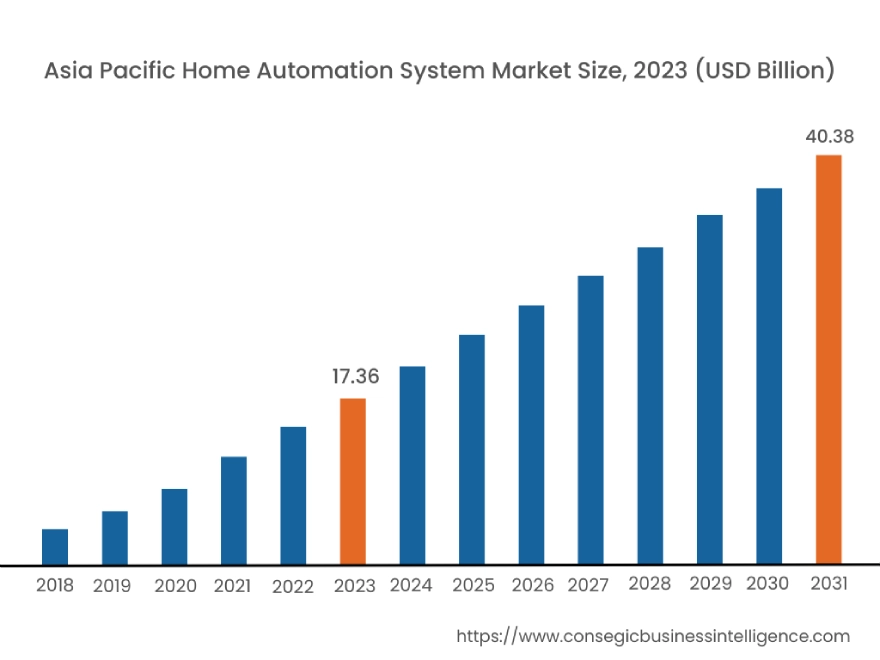
Asia Pacific region was valued at USD 17.36 Billion in 2023. Moreover, it is projected to grow by USD 18.95 Billion in 2024 and reach over USD 40.38 Billion by 2031. Out of this, China accounted for the maximum revenue share of 31.3%. As per the analysis, Asia Pacific is experiencing rapid growth in the smart kitchen market, driven by increasing urbanization and smart home appliances including entertainment. Countries including China, South Korea, India, and Japan are leading the home automation system market.
- In August 2022, Samsung Electronics (South Korea) introduced SmartThings Home Life to provide a comprehensive smart home experience to customers globally. SmartThings Home Life is a recent feature in the SmartThings app that offers convenient and all-in-one control of Samsung home appliances.
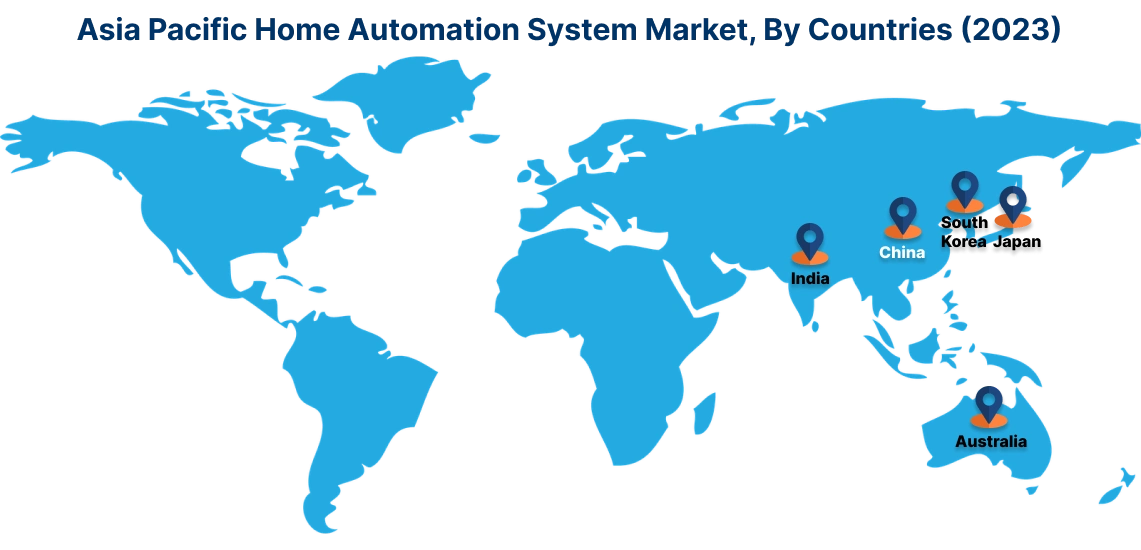
North America is estimated to reach over USD 53.10 Billion by 2031 from a value of USD 23.63 Billion in 2023 and is projected to grow by USD 25.73 Billion in 2024. The home automation system market in North America is currently leading the global market, with a pronounced emphasis on advanced security solutions. This segment is experiencing significant growth due to the increasing consumer demand for integrated security systems that offer comprehensive protection. Innovations such as sophisticated alarm systems and autonomous surveillance cameras are at the forefront of this expansion, reflecting a broader trend toward enhanced safety and seamless integration in home automation.
- In September 2021, Ring (US) unveiled several new home security innovations, including the Ring Alarm Pro—a system combining security with a built-in eero Wi-Fi 6 router—and the Ring Always Home Cam, an autonomous flying camera. The Virtual Security Guard service offers professional monitoring for outdoor cameras, while Custom Event Alerts use computer vision for tailored notifications.
In Europe, the home automation system market is expanding slowly, in tandem with greater interest in smart home technologies and energy-saving solutions. This development is also being fueled by the trend of increased uptake of security systems such as elaborate surveillance cameras and alarm systems. Additionally, European consumers are increasingly favoring integrated systems for both security and convenience purposes.
According to the analysis, Latin America is experiencing growth in the home automation sector but at a comparatively lower speed than other regions. Here, emphasis is laid on cheaper options that contain basic features for both automation and safety measures. Nevertheless, urbanization and economic growth are increasing an urge for improved advanced home automation and safety mechanisms.
In the Middle East and Africa, the home automation market is booming, attested by well-off residents as well as people who are getting more interested in living sophisticatedly using advanced technologies. People living here tend to have worries about their safety thus they put more emphasis on high-end security systems that may include alarms integrated with surveillance devices in this region.
Top Key Players & Market Share Insights:
The home automation system market is highly competitive with major players providing smart homes to the national and international markets. Key players are adopting several strategies in research and development (R&D), product innovation, and end-user launches to hold a strong position in the home automation system market. Key players in the home automation system industry include-
- Honeywell International Inc. (U.S.)
- Samsung Electronics Co., Ltd. (South Korea)
- Acuity Brands, Inc. (U.S.)
- Johnson Controls Inc. (U.S.)
- United Technologies Corporation (U.S.)
- Savant Systems Llc. (U.S.)
- Apple, Inc. (US)
- Crestron Electronics, Inc. (U.S.)
- Legrand (France)
- Schneider Electric Se (France)
- Abb Ltd. (Switzerland)
- Siemens (Germany)
Recent Industry Developments :
Product Launch:
- In January 2024, Samsung announced its newest line of home appliances with improved connectivity and AI capabilities. The latest Bespoke AI appliances from Samsung include built-in Wi-Fi, internal cameras, and AI chips, and are compatible with the SmartThings app, enhancing connectivity for a smarter home.
- In January 2023, Apple launched the HomePod (2nd generation), enhancing the home automation experience with its advanced audio capabilities and seamless smart home integration. The new speaker offers immersive Spatial Audio and hands-free smart home controls through Siri, allowing users to create automation, receive critical alerts for smoke and carbon monoxide, and monitor room conditions.
Product Enhancement:
- In February 2024, Vivint Smart Home improves its smart security by introducing Vehicle Detection for Outdoor Camera Pro, a new feature that utilizes AI technology to recognize vehicle activity within a specific detection area. Detection of vehicles enhances your safety by providing immediate alerts and recordings whenever a vehicle enters the specified location.
- In June 2023, Vivint (US) will expand Smart Home Experience with Vivint Smart Lighting, an elegant lighting solution designed to make homes safer, smarter, and more sustainable. Vivint Smart Lighting enables you to place switches anywhere, doesn't require electrical work, ensures dependable connectivity, and expands the smart home capabilities in your home.
Collaboration:
- In January 2024, Samsung teamed up with Tesla to enhance SmartThings Energy, adding more connectivity and assisting Samsung in enhancing home experiences for consumers.
Home Automation System Market Report Insights :
| Report Attributes | Report Details |
| Study Timeline | 2018-2031 |
| Market Size in 2031 | USD 155.05 Billion |
| CAGR (2024-2031) | 10.6% |
| By Component |
|
| By Technology |
|
| By Application |
|
| By Region |
|
| Key Players |
|
| North America | U.S. Canada Mexico |
| Europe | U.K. Germany France Spain Italy Russia Benelux Rest of Europe |
| APAC | China South Korea Japan India Australia ASEAN Rest of Asia-Pacific |
| Middle East and Africa | GCC Turkey South Africa Rest of MEA |
| LATAM | Brazil Argentina Chile Rest of LATAM |
| Report Coverage |
|
Key Questions Answered in the Report
How big is the Home Automation System Market? +
The Home Automation System Market size is estimated to reach over USD 155.05 Billion by 2031 from a value of USD 69.01 Billion in 2023 and is projected to grow by USD 75.13 Billion in 2024, growing at a CAGR of 10.6% from 2024 to 2031.
What is the key market trend? +
There is a strong emphasis on energy-efficient smart lighting solutions driven by growing environmental consciousness and the push for sustainability. LED lighting systems with smart controls are becoming standard allowing users to reduce energy consumption.
Who are the major players in the home automation system market? +
Key players in the home automation system market include Honeywell International Inc. (U.S.), Samsung Electronics Co., Ltd. (South Korea), Apple, Inc. (US), Acuity Brands, Inc. (U.S.), Johnson Controls Inc. (U.S.), United Technologies Corporation (U.S.), Crestron Electronics, Inc. (U.S.), Legrand (France), Schneider Electric Se (France), Abb Ltd. (Switzerland), Siemens (Germany), Savant Systems Llc. (U.S.) and others.
Which region will lead the global home automation system market? +
Asia Pacific region is expected to register the fastest CAGR of 10.7% during the forecasted period.
